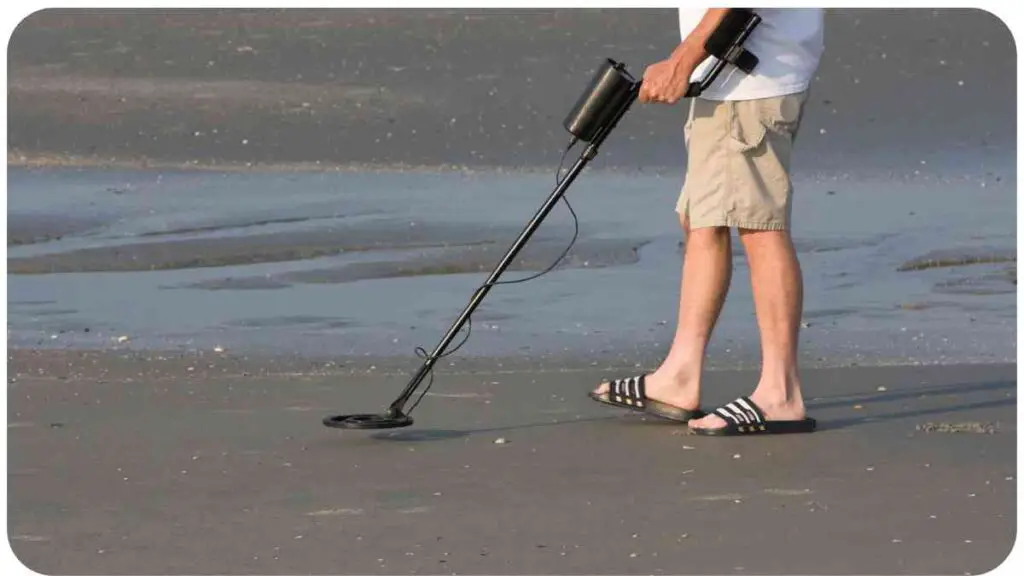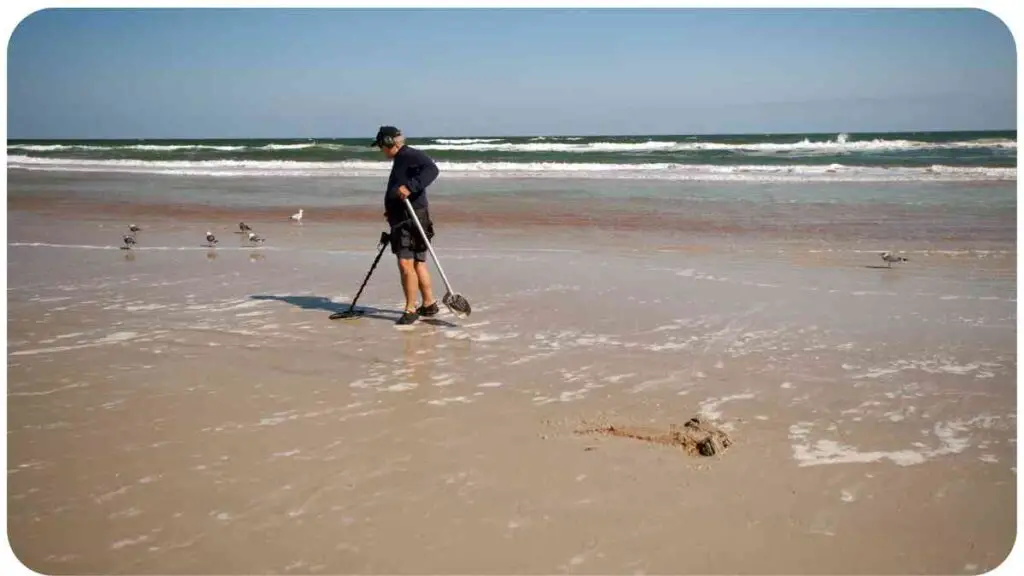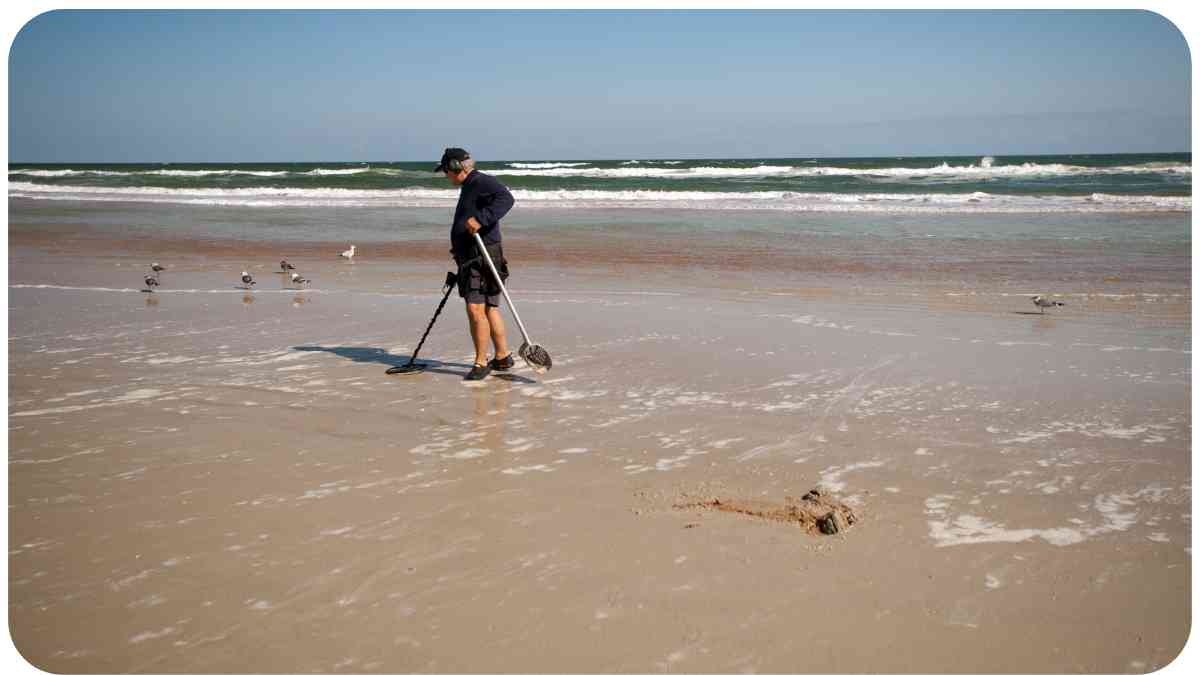Wet metal detectors, often used in underwater metal detection, need to be chosen and used carefully due to their operating conditions. When dealing with a wet metal detector, here are several key factors to consider:
Key Factors to Consider When Dealing with a Wet Metal Detector
| Factors | Importance |
| Prompt action | High |
| Understanding technology | Essential |
| Proper drying techniques | Crucial |
| Preventative maintenance | Recommended |
When you embark on the exciting adventure of treasure hunting, unexpected challenges may arise, such as encountering inclement weather or accidentally submerging your metal detector in water. Water exposure can pose a significant risk to your detector’s functionality, but fear not!
In this comprehensive guide, we will explore effective strategies for dealing with a wet metal detector, ensuring that you can continue your treasure hunt without interruption.
By incorporating my extensive experience and expertise as a seasoned treasure hunter, we will delve into the steps to follow, tools to use, and preventative measures to adopt to keep your detector in optimal condition. Get ready to uncover the secrets of salvaging a wet metal detector!
Metal detecting is more than just a hobby; it’s an adventure filled with endless possibilities. If you’re just getting started or want to enhance your skills, delve into the Beginner’s Guide to Metal Detecting to unlock new horizons
Understanding the Risks of Water Exposure to Metal Detectors
Table: Potential Risks of Water Exposure to Metal Detectors
| Risks | Impact |
| Circuit damage | Loss of functionality and accuracy |
| Corrosion of internal components | Reduced lifespan and performance |
| Waterproofing compromise | Voided warranty and increased repair costs |
| Mineral buildup and saltwater | Interference with signal detection abilities |
Water exposure can pose various risks to the delicate components of your metal detector. The circuitry inside the device is particularly vulnerable and can suffer damage when exposed to moisture. This damage may result in loss of functionality or reduced accuracy when detecting targets.
Internal components are also at risk of corrosion when they come into contact with water. Corrosion can lead to a decrease in performance and ultimately shorten the lifespan of your detector.
If your detector is not specifically designed to be waterproof, water exposure can compromise the waterproofing seals, leading to internal damage. This can void the warranty and result in costly repairs. Additionally, mineral buildup and saltwater exposure can interfere with the detector’s signal detection abilities, making it more challenging to locate targets accurately.
Understanding these risks highlights the importance of taking immediate action when your metal detector gets wet. By following the appropriate steps, you can minimize the damage and restore your detector to its optimal condition.
Precautions to Take Before Detecting in Wet Conditions
Table: Precautions to Take Before Detecting in Wet Conditions
| Precautions | Benefits |
| Check weather conditions | Avoid detecting in heavy rain or thunderstorms |
| Invest in a waterproof metal detector | Ensure device protection in wet environments |
| Use a protective cover or bag | Shield the detector from water and dirt |
| Double-check battery compartment seal | Prevent water infiltration |
| Wear appropriate waterproof gear | Keep yourself comfortable and dry |
Before heading out for a treasure hunting session in wet conditions, it is essential to take a few precautions to protect your metal detector and yourself from potential water damage. Start by checking the weather forecast to avoid detecting during heavy rain or thunderstorms. Detecting in extreme weather conditions increases the likelihood of water exposure and may pose a safety risk.
Investing in a waterproof metal detector is a wise decision if you anticipate frequently detecting in wet environments. These detectors are designed to withstand water exposure, ensuring their functionality and longevity. Consider the depth rating of the detector to determine its water resistance capabilities.
Using a protective cover or bag for your detector provides an extra layer of defense against water and dirt. These covers are typically designed to fit the specific model of your detector and can help shield it from splashes, rain, and other elements.
Always double-check the seal of the battery compartment. Ensure it is tightly closed and sealed to prevent water infiltration. Water entering the battery compartment can damage the internal circuitry and lead to malfunctions.
Finally, remember to wear appropriate waterproof gear yourself. This includes waterproof boots, a rain jacket, and even waterproof gloves if necessary. Keeping yourself dry and comfortable will enhance your treasure hunting experience.
To truly master the art of metal detecting, one needs guidance from the experts. Discover advanced techniques and insider advice in the article on Maximizing Your Metal Detecting Skills and elevate your treasure hunting experience.
4. Steps to Follow if Your Detector Gets Wet

Table: Steps to Follow if Your Detector Gets Wet
| Steps | Description |
| Remove the battery | Prevent potential damage |
| Rinse off with fresh water (if necessary) | Remove saltwater or other contaminants |
| Pat dry with a soft cloth | Remove excess moisture |
| Disassemble (if possible) and air dry | Ensure thorough drying of internal components |
| Use a moisture-absorbing product | Speed up the drying process |
| Check for signs of damage | Assess the extent of potential issues |
| Reassemble and test functionality | Ensure proper functioning before next use |
If your metal detector gets wet, it is crucial to take immediate and appropriate action to minimize any damage. Follow these steps to effectively handle a wet detector:
Remove the battery: The first step is to remove the battery if it is still attached. This will prevent any potential damage to the electrical circuitry.
Rinse off with fresh water (if necessary): If your detector was exposed to saltwater or other contaminants, it may be necessary to rinse it off with fresh water. This helps remove any corrosive substances and prevents further damage. However, be cautious and refer to the manufacturer’s guidelines as not all detectors are suitable for rinsing.
Pat dry with a soft cloth: After rinsing or if your detector was exposed to freshwater, use a soft cloth to gently pat dry the exterior of the detector. This will help remove excess moisture.
Disassemble (if possible) and air dry: If your detector is designed to be disassembled, consider doing so to facilitate thorough drying. Allow the components to air dry completely, preferably in a dry and well-ventilated area. Avoid exposing the detector to direct sunlight or using external heat sources as this may damage the internal components.
Use a moisture-absorbing product: To speed up the drying process, you can place your detector and its components in a container with a moisture-absorbing product, such as silica gel. This helps to draw out any remaining moisture.
Check for signs of damage: After the detector is fully dried, inspect it carefully for any signs of damage or corrosion. Look for discolored areas, loose connections, or any unusual behavior. If you notice anything concerning, consult a professional or the manufacturer for further guidance.
Reassemble and test functionality: Once you are confident that the detector is dry and undamaged, reassemble it following the manufacturer’s instructions. Before using it again, test the functionality to ensure that it is working properly.
By following these steps, you can effectively address a wet detector and increase the chances of restoring it to full functionality.
Every tool requires maintenance, and metal detectors are no exception. Encountering issues with your device? Navigate the troubleshooting waters with our guide on How to Fix a Faulty Metal Detector and ensure uninterrupted treasure hunting.
Tools and Products to Help Dry and Restore Your Detector
Table: Tools and Products for Drying and Restoring Wet Detectors
| Tools and Products | Description |
| Silica gel packets | Absorb moisture and facilitate drying |
| Rice or uncooked oatmeal | Help absorb moisture |
| Air compressor | Remove trapped moisture from intricate components |
| Dehumidifier | Aid in drying process by reducing humidity levels |
| Electrical contact cleaner | Remove corrosion and improve electrical connections |
| Lubricant or rust inhibitor | Protect components from further damage |
| Microfiber cloth and soft brushes | Gently clean and remove debris from detector and components |
| Waterproof storage case or bag | Safely store detector and prevent future water damage |
When dealing with a wet metal detector, there are various tools and products that can help in the drying and restoration process. Consider utilizing the following:
Silica gel packets: These small packets contain silica gel, a moisture-absorbing substance. Placing them with your detector or its components in an airtight container can speed up the drying process and prevent further damage.
Rice or uncooked oatmeal: Rice and uncooked oatmeal are household items known to absorb moisture. You can place your detector in a container with rice or oatmeal, ensuring that the device is not directly in contact with the grains.
Air compressor: If you have access to an air compressor, you can use it to blow air through the various components of your detector. This helps remove any trapped moisture from intricate areas that may not be easily accessible.
Dehumidifier: Consider using a dehumidifier in the room where you are drying your detector. A dehumidifier reduces the humidity levels, helping to accelerate the drying process.
Electrical contact cleaner: If you notice signs of corrosion on the detector’s electrical connections, an electrical contact cleaner can be used to remove the corrosion and improve conductivity.
Lubricant or rust inhibitor: Once the detector is fully dry and clean, applying a small amount of appropriate lubricant or rust inhibitor to the necessary components can help protect them from future damage.
Microfiber cloth and soft brushes: Use a soft microfiber cloth to gently clean the exterior of the detector and its components. Soft brushes can also aid in removing debris or dirt from hard-to-reach areas.
Waterproof storage case or bag: Invest in a waterproof storage case or bag to keep your detector safe when not in use. This will help prevent future water damage and protect your investment.
By utilizing these tools and products, you can aid in the drying and restoration of your wet metal detector, ensuring its longevity and optimal performance.
Common Mistakes to Avoid When Dealing with a Wet Detector
Table: Common Mistakes to Avoid When Dealing with a Wet Detector
| Mistakes | Impact |
| Powering on the wet detector | Expose circuits to short circuits |
| Using excessive heat sources for drying | Cause damage to internal components |
| Neglecting to clean and dry all components | Encourage corrosion and further damage |
| Ignoring signs of damage or malfunction | Risk additional issues and costly repairs |
| Storing the wet detector without proper care | Lead to mold growth and further deterioration |
| Attempting repairs without professional guidance | Cause irreversible damage or void warranties |
When dealing with a wet metal detector, it’s vital to avoid certain common mistakes that could worsen the situation or lead to further damage. By steering clear of these mistakes, you can ensure the best possible outcome for your detector:
Powering on the wet detector: Do not attempt to power on your wet detector. This can cause short circuits and irreparable damage to the internal circuits. Instead, follow the proper steps for drying and inspecting the detector before using it again.
Using excessive heat sources for drying: Avoid using excessive heat sources, such as hairdryers or heaters, to dry your detector. High temperatures can damage the internal components and exacerbate the water-related issues. Stick to natural air drying methods.
Neglecting to clean and dry all components: Ensure that you thoroughly clean and dry all components of your detector, including the battery compartment, control panel, and coils. Neglecting any part may lead to corrosion or other complications in the future.
Ignoring signs of damage or malfunction: If you notice any signs of damage, corrosion, or malfunction after drying your detector, do not ignore them. Address the issues promptly to prevent further damage and potential costly repairs.
Storing the wet detector without proper care: Do not store your wet detector in a damp or humid environment. This can promote mold growth and deteriorate the internal components. Make sure your detector is completely dry before storing it in a clean, dry place.
Attempting repairs without professional guidance: Unless you have professional experience and knowledge, it is advisable to seek expert guidance for repairs. Attempting to repair the detector yourself without proper understanding can lead to irreversible damage or voiding warranties.
Avoiding these common mistakes will help protect your detector and increase the chances of restoring it to its optimal performance.
Continuous beeping from your metal detector can be both annoying and perplexing. Before jumping to conclusions, explore the Easy Fix for Beeping Metal Detectors to address and resolve the mystery behind the sound.
Tips for Preventing Water Damage to Your Detector

Table: Tips for Preventing Water Damage to Your Detector
| Tips | Description |
| Use waterproof or water-resistant detectors | Opt for models specifically designed for water resistance |
| Stay aware of weather conditions | Avoid detecting in heavy rain or near bodies of water during storms |
| Take extra caution near water bodies | Be mindful of waves, tides, and potential water splashes |
| Utilize a protective cover or bag | Shield the detector from water, dirt, and other potential damage |
| Secure battery compartments and seals | Ensure tight seals to prevent water infiltration |
| Avoid submerging non-waterproof detectors | Keep detectors out of water unless explicitly designed for submersion |
| Regularly maintain and clean your detector | Remove dirt, debris, and moisture to prolong its lifespan and accuracy |
Preventing water damage to your metal detector is key to maintaining its functionality and performance. Follow these tips to avoid potential water-related issues:
Use waterproof or water-resistant detectors: Invest in metal detectors that are specifically designed to be waterproof or water-resistant. These models are built to withstand varying levels of water exposure, ensuring their durability and functionality in wet conditions.
Stay aware of weather conditions: Check the weather forecast before heading out for a detecting session. Avoid detecting in heavy rain or during thunderstorms. Stay away from bodies of water during storms to minimize the risk of water damage.
Take extra caution near water bodies: If you’re detecting near water bodies, such as beaches or rivers, be mindful of waves, tides, and potential water splashes. These can lead to accidental water exposure if you’re not careful.
Utilize a protective cover or bag: Invest in a protective cover or bag for your detector. These covers are designed to shield your detector from water, dirt, and other potential damages. Always use them when your detector is in use or in storage.
Secure battery compartments and seals: Ensure that the battery compartments and all seals on your detector are properly secured. Tighten seals and check for any signs of wear or damage. This will prevent water infiltration and potential damage to the internal components.
Avoid submerging non-waterproof detectors: Unless your detector is specifically designed for submersion, avoid completely submerging it in water. Non-waterproof detectors are not built to handle extensive water exposure and may suffer irreparable damage.
Regularly maintain and clean your detector: Regularly clean your detector after each use to remove dirt, debris, and any moisture. Pay attention to cleaning the coils, control panel, and battery compartment to prevent buildup and potential water-related issues.
By implementing these prevention tips, you can significantly reduce the risk of water damage to your metal detector and maximize its lifespan.
The world of metal detecting is vast, with various tools enhancing the experience. If you’re caught between choices, our comprehensive article on Metal Detector vs. Pinpointer will shed light on the intricacies and help you make an informed decision.
Conclusion
Taking proper care of your metal detector, especially when it comes to water exposure, is crucial for maintaining its functionality and prolonging its lifespan. Understanding the risks and following the necessary precautions can help you avoid potential damage. Remember to check weather conditions, invest in a waterproof detector if needed, use protective covers, and ensure battery compartment seals are secure.
In the event that your detector does get wet, it’s important to follow the appropriate steps for drying and restoring it. Remove the battery, rinse if necessary, pat dry, disassemble if possible, and utilize moisture-absorbing products. Check for signs of damage or corrosion before reassembling and testing functionality.
Be mindful of common mistakes to avoid, such as powering on a wet detector, using excessive heat sources for drying, neglecting to clean and dry all components, ignoring signs of damage, storing the wet detector without proper care, and attempting repairs without professional guidance.
By following these guidelines and incorporating preventive measures, you can enjoy your metal detecting adventures while minimizing the risk of water damage to your detector. Happy detecting!
Further Reading
Here are some additional resources that you may find helpful for further information on dealing with wet metal detectors and metal detecting near water:
Forum Discussion on TreasureNet – “Garrett 150 Got Wet”: This forum thread discusses the experience of a user whose Garrett 150 metal detector was exposed to water, providing insights and potential solutions.
Metal Detecting Near Water: What You Need to Know: This article provides tips and considerations for metal detecting near water bodies, highlighting the potential benefits and challenges of this specific environment.
Do Metal Detectors Work Better When the Ground Is Wet?: This article discusses the impact of wet ground on metal detecting, addressing whether metal detectors perform better under wet conditions and providing information on how moisture affects detection.
FAQs
Here are some frequently asked questions about dealing with wet metal detectors:
Can I use my metal detector in the rain?
Many metal detectors are designed to withstand light rain, but prolonged exposure to heavy rain can damage the detector. It’s advisable to avoid using your detector in heavy rain to prevent potential water damage.
How do I clean my metal detector after it gets wet?
After your metal detector gets wet, carefully disassemble it (if possible) and dry each component thoroughly. Use a soft cloth to remove moisture, and consider using moisture-absorbing products or silica gel to aid in the drying process.
Can I rinse my metal detector with water to clean it?
Rinsing your metal detector with freshwater can be helpful in removing saltwater or other contaminants. However, not all detectors are suitable for rinsing, so it’s essential to check the manufacturer’s guidelines before doing so.
What should I do if my metal detector doesn’t work after getting wet?
If your metal detector doesn’t work after getting wet, try removing the battery and drying the detector thoroughly. If the issue persists, consult the manufacturer or a professional for further guidance or repairs.
Are there specific metal detectors designed for wet or underwater use?
Yes, there are metal detectors specifically designed for wet or underwater use. These detectors are typically labeled as waterproof or water-resistant, allowing you to safely use them in wet environments, such as beaches or shallow water.

Hi there! My name is Hellen James, and I’m here to talk to you about treasure hunting. I’ve been a fan of treasure hunting ever since I was a kid, and if you’re a fan of treasure hunting or just like the idea of finding a long-lost fortune, then this blog is for you.

